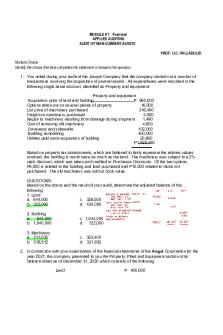3 - Current Purchasing Power PDF

| Title | 3 - Current Purchasing Power |
|---|---|
| Author | Catherine Mitchell |
| Course | Advanced Financial Accounting |
| Institution | University of Stirling |
| Pages | 2 |
| File Size | 87.4 KB |
| File Type | |
| Total Downloads | 80 |
| Total Views | 144 |
Summary
Download 3 - Current Purchasing Power PDF
Description
ACCU9AA WEEK THREE : CURRENT PURCHASING POWER - NOTES Historical Cost Accounting Proprietary Financial Historic Costs Nominal £s
View of Firm Capital Maintenance Valuation Base Unit of Measurement
Current Purchasing Power Proprietary Financial Historic Costs Real £s (adjusted for inflation)
HCA v CPP
Example: Shareholders contributed £10,000 a year ago. Profit for the year using HCA is £5,000. Inflation has been 20% If all £10,000 goes back to the shareholders, their capital would have eroded. Amount of money with the same purchasing power now as £10,000 did one year ago: 10,000 x 120/100 = £12,000 Of the £5,000 profit, £2,000 should be retained as a capital maintenance reserve (12,000 – 10,000), and £3,000 can be redistributed to shareholders There is £5,000 surplus once shareholders nominal financial capital is maintained, and £3,000 surplus once real financial capital is maintained.
Preparing a Set of CPP Financial Statements Basic approach – index the HC accounts so everything is stated in year-end £s to ensure real financial capital is maintained CPP value = HC x (year-end retail price index / index at date transaction occurred) Historical cost is updated to reflect a change in the current purchasing power of money between the date the transaction occurred and the year-end balance sheet date
Example: At date 1, 10 items of stock are bought for £300 and the RPI is 100. At date 2, 10 items of stock are bought for £330 and the RPI is 110. At the year end, 20 items of stock are left and the RPI is 120. What is the current purchasing power of the assets? RPI HCA CPP
1 100 300 300 x (120/100) = 360
2 110 330 330 x (120/110) = 360
3 120 630 =720
Non-Monetary Assets Physical presence (e.g. plant, inventory, buildings) hold real value even if there is inflation – holding on to an asset when prices are rising is good – it would have cost more to buy now than before Money value is understated at historical cost Indexation is required to update to current terms
ACCU9AA WEEK THREE : CURRENT PURCHASING POWER - NOTES
Monetary Items Don’t require indexing Items are denominated in nominal terms as the value is fixed Examples include debtors, creditors, cash, loans (no physical presence) Benefit from having monetary liabilities in times of inflation Loss from having monetary assets in times of inflation
Example: A loan of £4,000 was taken out in 2001 when the RPI was 50. It is now 116. What is the gain/loss on the loan? If a loan having the same purchasing power as £4,000 in 2001 was taken out today, it would need to be for 4,000 x (116/50) = £9,280. Thus, there is a gain on borrowing of 9280 – 4000 = £5,280, which appears in the income statement
When there is inflation, there’s a loss in relation to an increase in monetary assets and gain in relation to increase in monetary liabilities When there is inflation, there’s a gain in relation to a decrease in monetary assets and a loss in relation to a decrease in monetary liabilities Gains and losses are recorded in the income statement...
Similar Free PDFs

3 - Current Purchasing Power
- 2 Pages

3 NUMERICAL OVER CURRENT
- 3 Pages

Week 3 Power Psych
- 4 Pages

Purchasing & Supply notes
- 6 Pages

Week 3: External Affairs Power
- 5 Pages

Unit 3 - Power and Resistance
- 3 Pages

Current meter
- 6 Pages

Chapter 11-Current Liabili
- 104 Pages

Audit of non-current
- 7 Pages

Current Liabilities - Wholesome
- 4 Pages
Popular Institutions
- Tinajero National High School - Annex
- Politeknik Caltex Riau
- Yokohama City University
- SGT University
- University of Al-Qadisiyah
- Divine Word College of Vigan
- Techniek College Rotterdam
- Universidade de Santiago
- Universiti Teknologi MARA Cawangan Johor Kampus Pasir Gudang
- Poltekkes Kemenkes Yogyakarta
- Baguio City National High School
- Colegio san marcos
- preparatoria uno
- Centro de Bachillerato Tecnológico Industrial y de Servicios No. 107
- Dalian Maritime University
- Quang Trung Secondary School
- Colegio Tecnológico en Informática
- Corporación Regional de Educación Superior
- Grupo CEDVA
- Dar Al Uloom University
- Centro de Estudios Preuniversitarios de la Universidad Nacional de Ingeniería
- 上智大学
- Aakash International School, Nuna Majara
- San Felipe Neri Catholic School
- Kang Chiao International School - New Taipei City
- Misamis Occidental National High School
- Institución Educativa Escuela Normal Juan Ladrilleros
- Kolehiyo ng Pantukan
- Batanes State College
- Instituto Continental
- Sekolah Menengah Kejuruan Kesehatan Kaltara (Tarakan)
- Colegio de La Inmaculada Concepcion - Cebu





